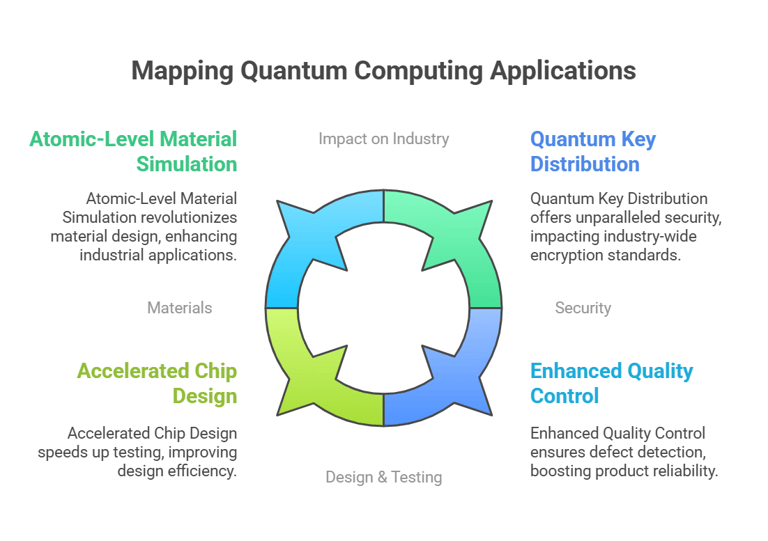A Quantum Leap Forward: The Next Era of Electronics Manufacturing
For designers, engineers, and decision-makers, quantum computing is not a distant speculation—it’s an emerging toolset with real-world applications.
2/20/20255 min read


Imagine you’re in a design meeting, mapping out the future of electronics—a chip that’s smaller, faster, and more energy-efficient than anything on the market. The room is filled with ideas, but there’s an unspoken tension: we’re approaching the limits of conventional silicon. Transistors can only shrink so much, heat dissipation is a growing nightmare, and testing new designs takes months. Enter quantum computing—not just a sci-fi fantasy, but a transformative technology poised to revolutionize electronics manufacturing.
For designers, engineers, and decision-makers, quantum computing is not a distant speculation—it’s an emerging toolset with real-world applications. In this article, we’ll explore why quantum computing could be the catalyst for the next generation of electronics, offering tangible benefits in material science, design optimization, and security.
Quantum Computing Basics: What’s Under the Hood?
At the heart of quantum computing is the qubit, which, unlike classical bits (restricted to either 0 or 1), can exist in a state of 0, 1, or both simultaneously, thanks to the principle of superposition. Imagine flipping a coin and having it land in a perpetual mid-air spin—until observed, it exists in multiple states.
Another key property is entanglement, where qubits become interdependent regardless of distance. Changing the state of one instantaneously affects its entangled counterpart—a phenomenon so mind-boggling that Einstein famously called it “spooky action at a distance.”
These principles allow quantum computers to perform complex calculations exponentially faster than classical machines. While today’s supercomputers analyze problems linearly, quantum computers can process multiple possibilities at once, making them particularly suited for solving optimization, simulation, and encryption challenges.
The Bottlenecks in Electronics Manufacturing
The End of Moore’s Law
For decades, Moore’s Law—predicting transistor densities doubling approximately every two years—has driven semiconductor advancements. But we’re reaching a physical limit. Today’s cutting-edge chips, like TSMC’s 3nm nodes, face quantum tunneling issues, where electrons unpredictably leak through thin barriers, causing power loss and overheating.
The industry is already seeing diminishing returns in performance improvements. Intel’s struggle to transition from 10nm to 7nm processes and IBM’s recent breakthrough in 2nm technology highlight the massive R&D and capital investments required to sustain progress. With such constraints, alternative computing paradigms are needed.
Lengthy and Costly Design Cycles
Simulating new semiconductor materials and chip architectures takes months using classical computers. For instance, NVIDIA’s latest GPUs undergo extensive iterations before production, with each cycle requiring vast computational power to test power efficiency, thermal behavior, and failure rates. Any late-stage design flaw forces costly redesigns.
Supply Chain and Security Risks
With globalized supply chains, chip security is increasingly a concern. The 2020 SolarWinds cyberattack exposed vulnerabilities in software supply chains, and hardware-based threats are even more insidious. Counterfeit components, trojan-infected firmware, and espionage risks in chip fabs highlight the need for new security models.
Quantum Computing Applications: Revolutionizing Electronics
Material Discovery and Optimization
One of the most immediate benefits of quantum computing is in materials science. Traditional methods rely on trial-and-error simulations to discover new semiconductors or superconductors. Quantum computers, however, can model atomic interactions with unprecedented accuracy.
For example, in 2021, IBM’s quantum researchers simulated the behavior of beryllium hydride, the simplest molecule requiring quantum chemistry. Extending this approach, companies like Google’s DeepMind are developing quantum algorithms to predict material properties, which could lead to new energy-efficient chip substrates beyond silicon, such as graphene or gallium nitride.
Quantum simulations also optimize manufacturing processes. For instance, Samsung and Google are investing in quantum algorithms to reduce defects in OLED displays, minimizing waste and improving production efficiency.
Accelerating Chip Design and Verification
Quantum algorithms excel in solving combinatorial optimization problems, which are at the heart of chip design. Google’s Sycamore quantum processor has demonstrated the ability to solve complex equations in minutes that would take classical computers thousands of years.
Imagine running simultaneous simulations of ten potential chip architectures and receiving results within hours instead of weeks. A practical example is D-Wave’s quantum annealers, already being used in logistics and scheduling. Applied to semiconductors, these could optimize floor planning in chip layouts, reducing power consumption and heat generation.
Additionally, quantum-powered machine learning could refine defect detection in semiconductor wafers. IBM has explored quantum-assisted AI to analyze microscopic defects in silicon wafers, ensuring higher manufacturing yields.
Unbreakable Security in Electronics
As processors become more powerful, traditional cryptographic methods are at risk. Today’s RSA encryption, which protects sensitive chip designs and manufacturing IP, can theoretically be cracked by quantum algorithms like Shor’s algorithm in minutes.
To counter this, quantum key distribution (QKD) is emerging as a solution. The Chinese government has successfully implemented QKD in its Micius satellite, enabling ultra-secure communication over thousands of kilometers. Companies like Toshiba and ID Quantique are developing commercial QKD solutions that could secure chip design data against industrial espionage.


Industry Adoption: Who’s Already Leveraging Quantum?
IBM and Samsung
IBM, a leader in quantum research, has partnered with Samsung to explore semiconductor optimizations using quantum computing. In early trials, IBM’s quantum systems successfully modeled material defects in next-gen memory chips, accelerating innovation in high-density storage solutions.
Google and TSMC
Google’s 2019 announcement of “quantum supremacy” stirred debate, but its real-world applications are clearer today. Google has since collaborated with Taiwan Semiconductor Manufacturing Company (TSMC) to apply quantum algorithms in process node optimization, reducing defect rates and improving yield for 5nm and below nodes.
Intel’s Quantum Simulations for Chip Packaging
Intel has invested in quantum research through its Horse Ridge quantum processor and is experimenting with quantum-assisted simulations to improve chip packaging. By leveraging quantum mechanics, Intel aims to reduce thermal resistance in 3D-stacked chip designs, potentially leading to more powerful AI accelerators.
Future Outlook: The Road to Quantum-Enhanced Manufacturing
While quantum computers are not replacing traditional semiconductor processes overnight, their impact is accelerating. Over the next decade, we can expect:
5-Year Horizon: Quantum-enhanced materials modeling leads to new substrates with lower energy consumption and higher performance.
10-Year Horizon: Quantum-assisted chip verification tools drastically cut design cycles, reducing costs and accelerating innovation.
15+ Years: Full-fledged quantum computing integration into chip manufacturing results in ultra-efficient, AI-powered processors that redefine computing paradigms.
Conclusion: Time to Get Quantum-Ready
Quantum computing is not just hype—it’s a tangible technology that will reshape electronics manufacturing. For industry professionals, now is the time to get ahead:
Explore quantum resources. MIT, IBM, and Google offer free quantum computing courses.
Encourage R&D teams to experiment with quantum simulations. Even small projects can yield significant competitive advantages.
Engage with industry leaders. Collaborate with research institutions or join consortiums like the Quantum Economic Development Consortium (QED-C).
The electronics industry is at a turning point. Quantum computing won’t just help us design better chips—it will redefine how we build the technology of the future. The question isn’t if quantum will change the game; it’s who will be ready when it does.
